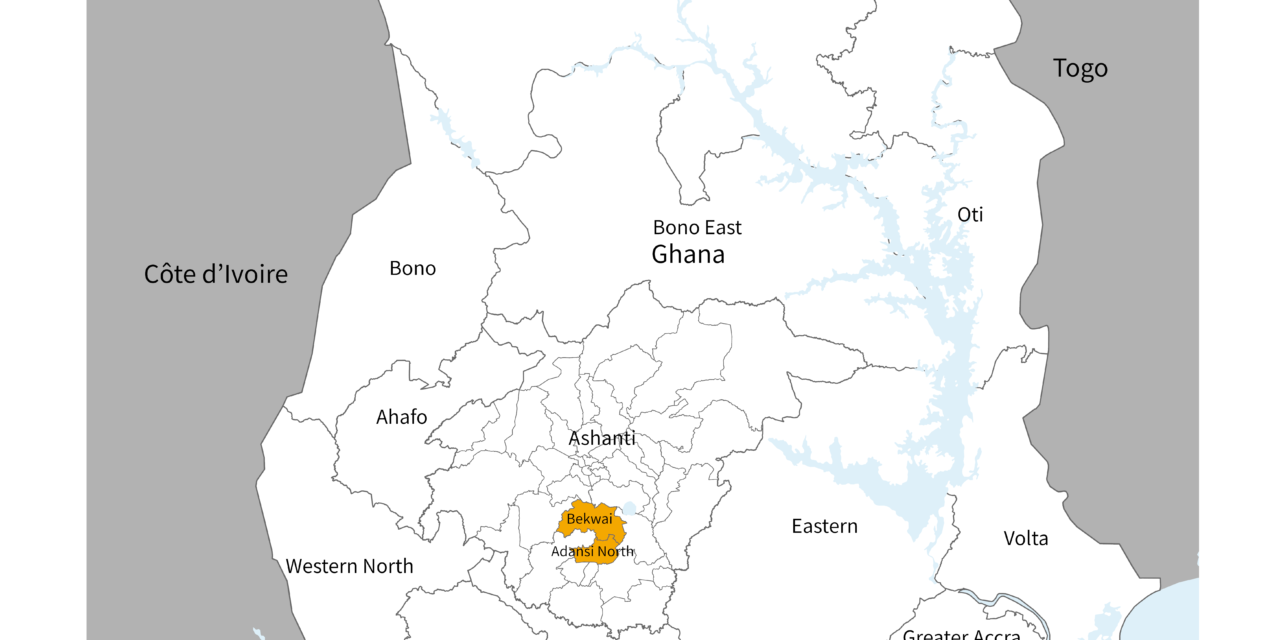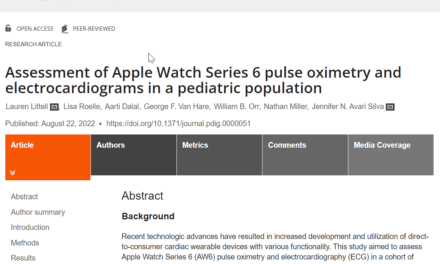Two fatal cases of Marburg virus disease (MVD) were reported from Ashanti region, Ghana. On 28 June 2022, these cases were notified to health authorities as suspected viral hemorrhagic fever (VHF) cases and tested positive for Marburg virus on 1 July 2022. An outbreak of MVD has only been reported once previously in West Africa, and this is the first time MVD has been notified in Ghana. An outbreak of MVD may represent a serious public health threat as it is severe and often fatal.
Description of the outbreak
On 28 June 2022, two suspected viral hemorrhagic fever (VHF) cases were notified to health authorities in the Ashanti region, Ghana (Figure 1). This region is located in the middle belt of Ghana and is the most populated region in the country.
The first case was a 26-year-old male who was a farm worker in Adansi North district, Ashanti region with a travel history to the Western region. Prior to symptom onset on 24 June, he arrived from the Western region to Ashanti region. He sought care at a hospital on 26 June and died on 27 June. The case was transported and buried in the Sawla-Tuna-Kalba district, Savannah region, which borders both Burkina Faso and Côte d’Ivoire. The burial was conducted before the results of laboratory tests for MVD were available.
The second case was a 51-year-old male who was a farm worker in Bekwai Municipal, Ashanti region. He sought care at the same hospital as the first case on 28 June but died the same day.
Both cases presented with fever, general malaise, bleeding from the nose and mouth, and subconjunctival bleeding (bleeding of the blood vessels in the eyes). Blood samples were collected on 27 June for the first case and 28 June for the second case and sent to Noguchi Memorial Institute of Medicine Research (NMIMR) for testing. On 1 July, both cases tested positive for Marburg virus by reverse transcriptase polymerase chain reaction (RT-PCR). On 12 July, samples collected from the two cases were sent to Institute Pasteur in Dakar, Senegal (IPD) which confirmed the results from NMIMR on 14 July 2022.
Figure 1. Region of the two confirmed cases of Marburg virus disease reported in Ghana, as of 20 July 2022
The source of infection is unknown. Preliminary investigations have shown that neither of these cases had a history of contact with dead animals, sick persons, or animals and had not attended any social gathering within three weeks of symptoms onset. Although both cases were farmers, they worked in different locations, and they have not been found to be epidemiologically linked. However, both cases came from communities living in a forest environment.
A cumulative number of 108 individuals (50 from Ashanti region, 48 from Savannah region, and 10 from the Western region) were identified as contacts of the two cases, all of whom were under self-quarantine and daily monitoring for 21 days. On 20 July, all contacts completed their follow up period. These contacts included health care workers and immediate family members of the cases. One contact reported some symptoms, but a blood sample that was collected tested negative at NMIMR on 7 July. All the other contacts reported to be in good health during the follow up period.
Epidemiology of the disease
MVD is an epidemic-prone disease associated with high case fatality ratios (CFR; 24-88%). In the early course of the disease, the clinical diagnosis of MVD is difficult to distinguish from many other tropical febrile illnesses due to the similarities in the clinical symptoms. Other VHFs need to be excluded, particularly Ebola virus disease, as well as malaria, typhoid fever, leptospirosis, rickettsial infections, and plague. Human MVD infection can result from prolonged exposure to mines or caves inhabited by Rousettus bat colonies. Marburg virus spreads through human-to-human transmission via direct contact (through broken skin or mucous membranes) with the blood, secretions, organs or other bodily fluids of infected people, and with surfaces and materials (e.g., bedding, clothing) contaminated with these fluids.
Although there are no vaccines or antiviral treatments approved to treat the virus, supportive care – rehydration with oral or intravenous fluids – and treatment of specific symptoms, improve survival. A range of potential treatments, including blood products, immune therapies, and drug therapies, are being evaluated.
Public health response
National and international coordination involving key partners are ongoing to respond to this outbreak.
- The Ministry of Health of Ghana is coordinating response activities and is engaging with partners for support, as needed.
- The Ashanti region health directorate established coordination mechanisms in the affected health districts and response activities have commenced.
- Epidemiological investigations continue to be conducted, including enhanced surveillance using the Integrated disease surveillance and Response (IDSR) system and follow-up of contacts. Eight alerts have been reported from Ashanti, Oti and Western regions. Following investigations, seven alerts were discarded and one alert from Oti region tested positive for yellow fever.
- Sensitization activities of health care workers on case definition and infection prevention and control measures are ongoing.
- The NMIMR laboratory has the capacity to test for viral hemorrhagic fevers and is testing samples resulting from alerts. To date, 15 samples were tested for Marburg virus, and all samples tested negative. Sequencing of the virus is ongoing.
- A designated hospital has been identified in Ashanti region to isolate and care for additional cases.
- WHO is deploying technical experts to support the country in strengthening Infection Prevention and Control (IPC), coordination, surveillance, and conducting investigations assessing risks for further outbreaks.
- An orientation has been held for community-based surveillance volunteers to enhance surveillance at the community level.
- WHO is offering testing support in the form of supplying reagents to NMIMR which first tested the samples.
- Côte d’Ivoire and Burkina Faso have been informed of the event and are initiating preparedness activities.
WHO risk assessment
The risk of this outbreak is high at the national level, moderate at the regional level, and low at the global level. The notification of two confirmed cases of MVD with a CFR of 100% (2/2) raises concern. The epidemiological investigation has not yet identified the source of this outbreak, which highlights the need to intensify the community-based surveillance.
There is a risk for this outbreak to spread to neighboring countries because the first case travelled from Western region prior to symptoms onset. The Western region shares a border with Côte d’Ivoire, and this may present a risk of transborder transmission if more cases continue to be reported or affect other areas. In addition, the first case was not buried safely in Savannah region which also borders Côte d’Ivoire and Burkina Faso. Therefore, WHO has assessed the risk of this outbreak as high at the national level, moderate at the regional level, and low at the global level.
WHO advice
- Reducing the risk of human-to-human transmission in the community arising from direct or close contact with infected patients, particularly with their body fluids. Close physical contact with Marburg patients should be avoided. Gloves and appropriate personal protective equipment should be worn when taking care of ill patients at home. Regular hand washing should be performed after visiting sick relatives in hospital, as well as after taking care of ill patients at home.
- Reducing the risk of bat-to-human transmission. Handle wildlife with gloves and other appropriate protective clothing. Cook animal products (blood and meat) thoroughly before consumption and avoid consuming raw meat. During work, research activities, or tourist visits in mines or caves inhabited by fruit bat colonies, wear gloves and other appropriate protective clothing including masks.
Outbreak containment measures should be continued and strengthened in the three regions of Ghana. These measures include:
- Maintaining and building trust with communities
- Scaling-up surveillance activities (active case search, contact monitoring, and investigation)
- Testing all suspected cases of MVD in a timely manner
- Ensuring that adequate infection prevention and control measures are implemented when caring for suspected, probable and confirmed patients
- Isolating early, and caring for suspected and confirmed cases, if possible, in designated health facilities with trained health workers and adequate IPC measures.
- Performing safe and dignified burial of deceased individuals who are probable or confirmed cases of MVD.
Marburg virus transmission has previously been reported in health care settings when appropriate infection prevention and control (IPC) measures were not implemented. IPC measures to reduce risk of transmission in health care include:
- Establish an IPC task force in the health zone to ensure implementation of the Infection prevention and control activities
- Ensure health workers are briefed on MVD (standard and transmission-based precautions) including an emphasis on safe injection practices
- Ensure minimum WASH and isolation requirements and capacity are met in health facilities.
Based on the current risk assessment WHO advises against any restriction of travel and trade to Ghana.
Further information
- WHO, Marburg Virus Disease health topic: https://www.who.int/health-topics/marburg-virus-disease#tab=tab_1
- WHO, Marburg Virus Disease fact sheet: https://www.who.int/news-room/fact-sheets/detail/marburg-virus-disease
- WHO, Ghana reports first-ever suspected cases of Marburg virus disease, 7 July 2022: https://www.afro.who.int/countries/ghana/news/ghana-reports-first-ever-suspected-cases-marburg-virus-disease
- WHO, Interim infection prevention and control guidance for care of patients with suspected or confirmed filovirus haemorrhagic fever in health-care settings, with focus on Ebola, 2014. https://apps.who.int/iris/handle/10665/130596
- Ghana Ministry of Health Press release on suspected Marburg Virus Diseases, 7 July 2022: https://twitter.com/_GHSofficial/status/1545113106828902401?s=20&t=PCl0VBd0LjORCwNFFvKnZw













